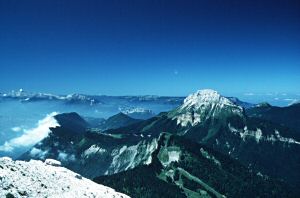
The French Subalpine Chains

The Subalpine chains of SE France are formed by folding and thrusting of Mesozoic limestones and shales together with the Tertiary foreland basin sediments. The Subalps are divided into a series of massifs separated by deep valleys. In general the highest peaks in the chains rise 2000m above the valley bottoms giving exceptional profiles through the structures. The region provides excellent opportunities for examining how the structural style changes in response to variations in the Mesozoic stratigraphy, basin structure and the thermal (burial) state of the rocks. It’s also possible to examine the structural evolution of individual fold-thrust complexes, gaining insight into the structural complexities of forelimb areas and the nature of thrust zones in carbonate-shale sequences. This web site gives a brief taste of the structures through some sample cross-sections, photographs and other information. Further images and information can be gleaned from the "virtual field trip" designed to support undergraduate teaching in Leeds.
 Thrusting
direction was towards WNW. Shortening varies, increasing from the Vercors (in the south, just a few
km shortening) up to the Swiss border (Morcles nappe – several 10s km). The timing
of deformation in the main Subalpine chains is constrained by age of molasse that is overthrust (late
Miocene). Thrusting terminated at the start Pliocene. There are no molasse sediments in this part
of the Alps that were deposited during local thrusting/folding. Deformation mechanisms in the southern
part of the belt are chiefly cataclasis and diffusional mass transfer.
Thrusting
direction was towards WNW. Shortening varies, increasing from the Vercors (in the south, just a few
km shortening) up to the Swiss border (Morcles nappe – several 10s km). The timing
of deformation in the main Subalpine chains is constrained by age of molasse that is overthrust (late
Miocene). Thrusting terminated at the start Pliocene. There are no molasse sediments in this part
of the Alps that were deposited during local thrusting/folding. Deformation mechanisms in the southern
part of the belt are chiefly cataclasis and diffusional mass transfer.
The material presented in these sites has previously been published in a series of articles:
Bowler, S. & Butler, R. 1991. Mountain building under the microscope. New Scientist 1764, 25-29.
Butler, R.W.H.1987. Thrust system evolution within previously rifted areas: an example from the Vercors, French subalpine chains. Mem. Geol. Soc. Italia 38, 5-18.
Butler, R.W.H.1989. The geometry of crustal shortening in the Western Alps. In: Tectonic evolution of Tethyan Regions (ed. B.C. Burchfiel & A.M.C. Sengor) Proc. NATO ASI, Kluwer, Dordrecht C259, 43-76.
Butler, R.W.H. 1989. The influence of pre-existing basin structure on thrust system evolution in the western Alps. In: Inversion Tectonics (ed. M.A. Cooper & G.D. Williams) Spec. Publs. Geol. Soc. London 44, 105-122.
Butler, R.W.H.1992. Evolution of Alpine fold-thrust complexes: a linked kinematic approach. In: Structural geology of fold and thrust belts (ed. S. Mitra & G. Fisher) Johns Hopkins University Press, Baltimore, 29-44.
Butler, R.W.H.1992. Structural evolution of the western Chartreuse fold-thrust system, NW French Subalpine chains. In: Thrust Tectonics (ed. K.R. McClay) Chapman & Hall, 287-298.
Butler, R.W.H.1992. Hydrocarbon maturation, migration and thrust sheet loading in the Western Alpine foreland thrust belt. In: Petroleum Migration (ed. A. Fleet & W. England) Spec. Publs. Geol. Soc. London 59, 227-244.
Butler, R.W.H. 1992. Thrusting patterns in the NW French Subalpine chains. Ann. Tect. 6, 150-172.
Butler, R.W.H. & Bowler, S.1995. Local displacement rate cycles in the life of a fold-thrust belt. Terra Nova 7, 408-416.
Welbon , A.I. & Butler, R.W.H.1992. Structural styles in thrust belts developed through rift basins: a view from the western Alps. In: Structural and Tectonic Modelling and its Application to Petroleum Geology (ed. R.M. Larsen) Norwegian Petroleum Society Spec. Publ. 1 , 469-479.
Banner image: Looking north from Grand Somm in the Chartreuse, as the Jura (left) diverge northwards from the Subalpine chains.
|| Alpine Tectonics ||